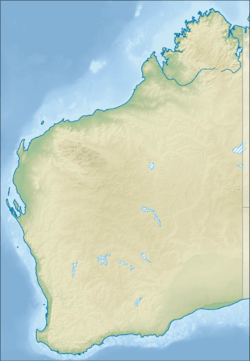Lake Bryde-East Lake Bryde facts for kids
Quick facts for kids Lake Bryde-East Lake Bryde |
|
|---|---|
| Location | Great Southern, Western Australia |
| Coordinates | 33°21′S 118°49′E / 33.350°S 118.817°E |
| Type | Wetlands |
| Basin countries | Australia |
| Designation | Lake Bryde Nature Reserve |
| Surface area | 1.9 km2 (0.73 sq mi) |
Lake Bryde-East Lake Bryde is a special freshwater wetland system in Western Australia. It is listed as an important wetland in Australia. This system actually has two lakes. One is called Lake Bryde, and it covers about 50 hectares (120 acres) (hectares). The other is East Lake Bryde, which is much larger at about 1.4 square kilometres (0.54 sq mi) (square kilometers).
These lakes are at the start of a long chain of lakes. This chain stretches all the way to Lake Magenta. Eventually, these lakes connect to the Swan-Avon river system.
Contents
Where is Lake Bryde-East Lake Bryde Located?
This important lake system is found in the Shire of Kent. This area is about 34 kilometres (21 mi) south-west of a town called Newdegate. The lakes are part of a larger natural area known as the Western Mallee. This region is famous for its unique plants and animals.
What Makes These Lakes Special?
The Lake Bryde-East Lake Bryde system is home to a very rare plant community. It is the only place in its region where you can find a lake bed covered mostly by shrubs. These shrubs are very important.
Critically Endangered Plants
Two main types of plants make up this special shrub community. One is called Muehlenbeckia horrida subsp. abdita. It is also known as Remote Thorny Lignum. This plant is in serious danger of disappearing forever. It is listed as a critically endangered species. The other important plant is Tecticornia verrucosa. Because these plants are so rare and important, their community has been named "Bryde". It is also listed as a critically endangered ecological community. This means the whole group of plants living together is at risk.
Why is the Lake Environment Changing?
The plants in these lakes need a special cycle to survive. The lakes usually flood with fresh water, then slowly dry out. This natural cycle helps the plants grow. However, things have changed since the 1980s. A lot of land around the lakes was cleared for farming. This caused the water underground to rise.
This rising water has brought a lot more salt into the lakes. The amount of salt in the lakes has jumped from 160 tons to about 1200 tons! Also, the way water flows into and out of the lakes has changed. This means the lakes are flooding much more often than they used to.
Protecting the Lakes and Plants
All these changes, especially the increased salt and frequent flooding, are harming the shrub beds. The special plants like Muehlenbeckia horrida subsp. abdita are struggling. To protect these plants and the unique environment, the lakes are now part of the Lake Bryde Nature Reserve. This reserve helps keep the area safe.
Wildlife at Lake Bryde-East Lake Bryde
The lake system is also a very important place for birds. Scientists have recorded sixteen different types of birds living there. This shows how important the lakes are for bird life. The lakes also have a greater variety of tiny water creatures (aquatic invertebrates) than other nearby lakes. This means the lakes are a healthy home for many different kinds of life.


